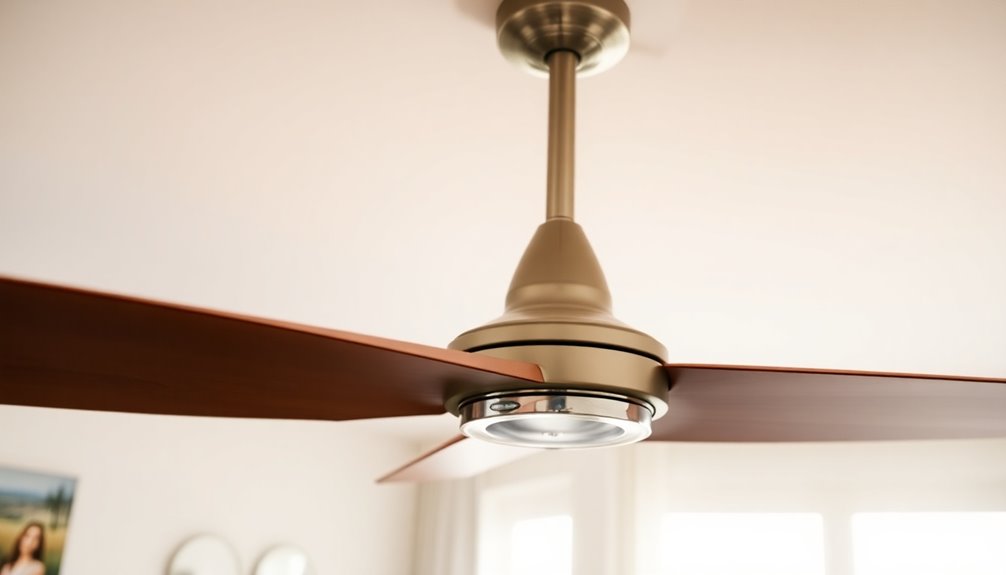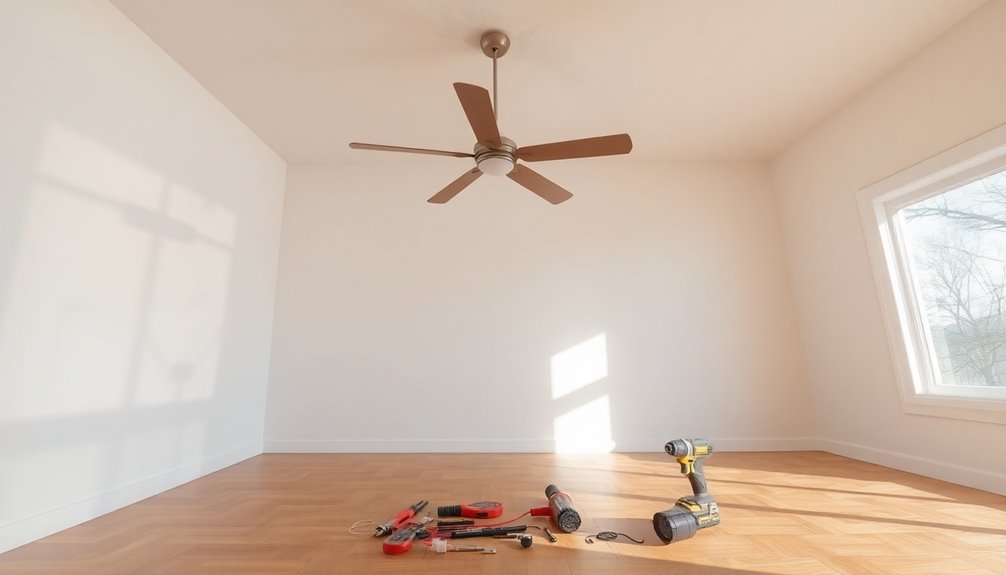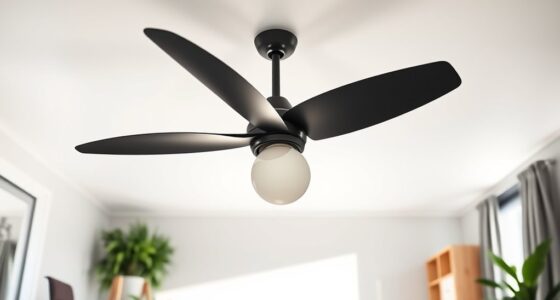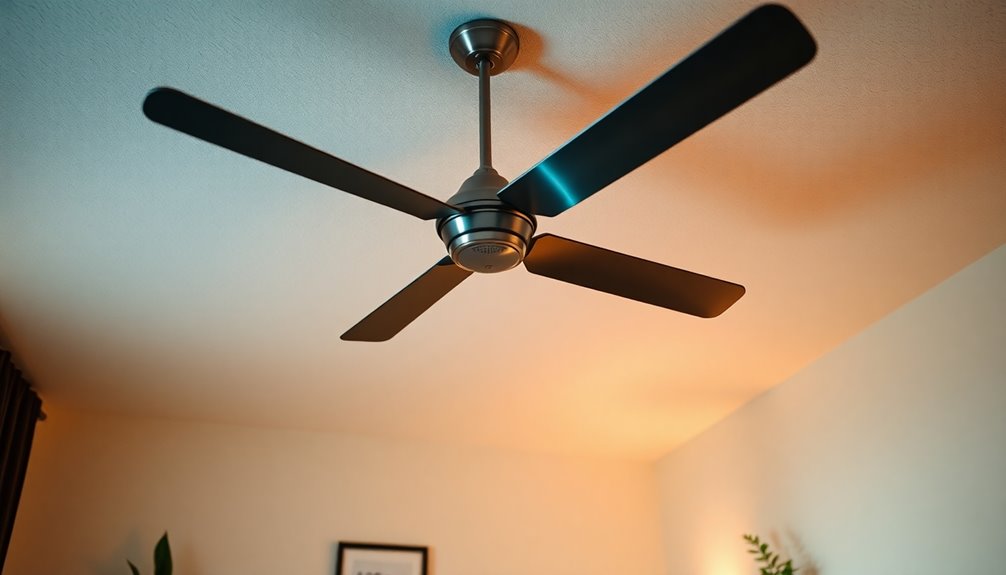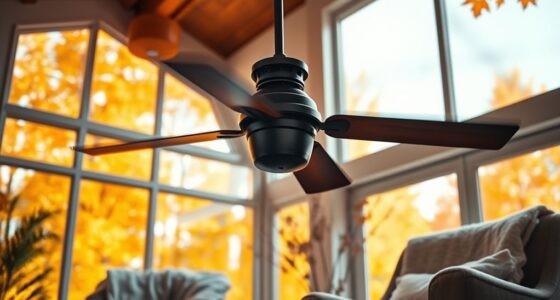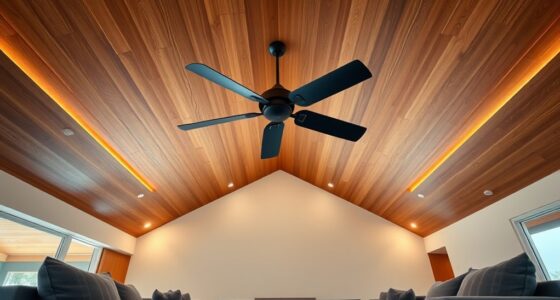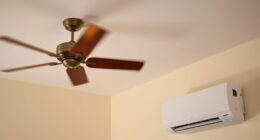Ceiling fans have a reverse switch so you can adjust airflow for both summer and winter comfort. In summer, a counterclockwise setting creates a cool breeze, helping you feel cooler without lowering the thermostat. In winter, switching to clockwise redistributes warm air down from the ceiling, keeping your space cozy. This simple adjustment can lead to energy savings of up to 15% on heating and cooling costs, making your fan a cost-effective climate control option. Understanding how these changes work can help you maximize your fan's efficiency throughout the year. There's plenty more to discover about optimizing your fan's performance!
Key Takeaways
- The reverse switch allows ceiling fans to rotate in both directions for optimized airflow throughout the year.
- In summer, counterclockwise rotation creates a cooling breeze, enhancing comfort and reducing air conditioning reliance.
- In winter, clockwise rotation redistributes warm air from the ceiling, maintaining a cozy environment and preventing temperature stratification.
- Using the reverse switch can lead to energy savings of up to 15% on heating and cooling costs.
- Proper fan direction adjustments can enhance air circulation, prolong HVAC system life, and improve overall energy efficiency.
Purpose of the Reverse Switch

Have you ever wondered why a ceiling fan has a reverse switch? This handy feature lets you change the direction of the fan blades, optimizing airflow for different seasons.
During summer, you can use the reverse switch to set the blades rotating counterclockwise. This creates a revitalizing wind-chill effect, making the room feel cooler and more comfortable.
As the seasons change, so does the need for warmth. In winter, flipping the reverse switch to clockwise helps circulate warm air that tends to gather near the ceiling. This simple adjustment improves heating efficiency, allowing you to enjoy a cozy atmosphere without cranking up the thermostat.
Not only does the reverse switch enhance comfort throughout the year, but it can also lead to energy savings. By circulating air effectively, you can reduce reliance on heating and cooling systems, potentially saving you up to 15% on energy bills.
Summer Fan Settings

To maximize comfort during the hot summer months, setting your ceiling fan to rotate counterclockwise is key. This counterclockwise movement pushes cool air downwards, creating a revitalizing breeze that enhances the cooling effect in your room. By increasing the wind-chill effect, you'll feel cooler without needing to lower your thermostat.
Using your ceiling fan correctly can also lead to energy savings. You can raise your thermostat setting by about 4 degrees while still feeling comfortable, reducing reliance on air conditioning and potentially saving up to 15% on your energy bills.
Here's a quick reference for understanding summer fan settings:
| Setting | Direction | Benefits |
|---|---|---|
| Ceiling Fan Blades | Counterclockwise | Creates a cooling breeze |
| Thermostat Setting | Higher | Reduces energy costs |
| Outdoor Ceiling Fans | Counterclockwise | Improves air circulation outdoors |
Be sure to adjust your ceiling fan blades accordingly and enjoy a more comfortable summer! Whether indoors or on your patio, the right fan setting can considerably enhance your summer experience.
Winter Fan Settings

During the winter months, adjusting your ceiling fan to rotate clockwise can greatly enhance your comfort at home. By using the reverse function, you can pull cooler air upwards, allowing the warmer air that rises to the ceiling to be pushed down along the walls and into your living space.
This clockwise rotation helps eliminate temperature stratification, ensuring a more even distribution of warmth throughout the room.
When you maintain a low speed during this clockwise rotation, you prevent the creation of downdrafts, which means you won't feel cold air blowing directly on you. This setup not only keeps your environment cozy but also increases the efficiency of your heating system.
In fact, utilizing this technique can potentially reduce your heating costs by up to 15%.
If you have high-mounted fans, you can leave them in clockwise mode year-round, as they effectively circulate air without needing to switch directions.
Adjusting Fan Direction

Adjusting the direction of your ceiling fan is a simple yet effective way to enhance your home's comfort and energy efficiency. By using the reverse switch, you can optimize the air direction based on the season. In summer, you'll want the fan to rotate counterclockwise to create a revitalizing breeze. Conversely, in winter, switching to a clockwise rotation helps circulate warm air that tends to rise to the ceiling.
Here's a quick reference table to help you remember the correct settings:
| Season | Blade Rotation | Purpose |
|---|---|---|
| Summer | Counterclockwise | Creates a cooling breeze |
| Winter | Clockwise | Distributes warm air evenly |
| Reverse | Toggle Switch | Changes blade direction |
| Control | Remote | Adjusts direction easily |
The reverse switch is typically found on the fan's motor housing or inside the switch cup. Many modern ceiling fans come with remote controls that include this function, making adjustments even more convenient. By correctly adjusting your fan's direction, you can greatly enhance your comfort while also reaping potential energy savings throughout the year.
Energy Savings Benefits

Reversing your ceiling fan can greatly lower your energy bills while enhancing heating efficiency in the winter.
By redistributing warm air, you can rely less on your furnace and enjoy year-round comfort.
Plus, using a ceiling fan consumes far less energy than an air conditioning unit, making it a smart choice for your home.
Lower Energy Bills
A simple switch can lead to significant savings on your energy bills. By using the reverse switch on your ceiling fan, you can optimize energy efficiency throughout the year. In winter, reversing the direction to clockwise helps circulate warm air that gathers near the ceiling, allowing your thermostat to detect warmth sooner. This adjustment can reduce your furnace's run time and lower energy bills by up to 15%.
Here's a quick comparison of energy usage:
| Appliance | Wattage |
|---|---|
| Ceiling Fan | 60 watts |
| Air Conditioning | 3,500 watts |
With a ceiling fan consuming only 60 watts, it's a cost-effective alternative to air conditioning. Adjusting the fan's direction seasonally allows you to raise your thermostat settings in winter, further cutting heating costs. Proper fan rotation enhances air circulation, which means you rely less on heating and cooling systems.
Enhanced Heating Efficiency
Ceiling fans can greatly enhance heating efficiency when used correctly during winter months. By simply flipping the fan reverse switch to a clockwise direction, you can push the warm air that gathers near the ceiling back down into the room. This effective circulation results in a more consistent and comfortable temperature throughout your space.
Using this method, you can potentially reduce your heating costs by up to 15%. With the ability to maintain higher thermostat settings without sacrificing comfort, it's a win-win.
Ceiling fans consume around 60 watts, vastly lower than air conditioning units that use about 3,500 watts. This makes them a much more energy-efficient option for distributing warm air in the winter.
As your ceiling fan pushes warm air downward, your thermostat senses the warmth sooner, which can lead to decreased furnace run time. This not only lowers your energy bills but also prolongs the life of your heating system by reducing its workload during the colder months.
Incorporating this simple adjustment in your heating and cooling routine can lead to significant savings and improved comfort.
Year-Round Comfort
Using ceiling fans effectively can consistently enhance your comfort throughout the year while saving energy.
One of the key features of ceiling fans is the reverse switch, which allows you to adjust the fan's direction based on the season. In winter, when you reverse your ceiling fan, it helps circulate warm air that tends to rise to the ceiling, potentially reducing your heating costs by up to 15%.
During summer, running your ceiling fan counterclockwise creates a wind-chill effect, making you feel cooler and allowing you to set your air conditioning at a higher temperature.
This can lead to additional savings on your energy bill, as ceiling fans consume about 60 watts compared to the hefty 3,500 watts used by air conditioning units. Additionally, using ceiling fans in conjunction with your heat pump can optimize energy efficiency by enhancing the performance of both systems.
Mechanism of Fan Reversal

Most ceiling fans feature a reverse switch that lets you easily change the direction of the motor's rotation. This mechanism is quite simple yet effective, allowing you to adapt your fan's functionality to the seasons.
Here's how it works:
- Counterclockwise Rotation: When you set the fan motor to spin counterclockwise, it pushes air downwards. This creates a cooling breeze that enhances comfort during warmer months.
- Clockwise Rotation: When you flip the reverse switch to make the fan spin clockwise, it pulls air upwards. This action redistributes warm air that collects near the ceiling, making your space feel cozier in winter.
- Energy Efficiency: By optimizing air circulation with the reverse switch, you can reduce your reliance on heating and cooling systems, leading to potential energy savings throughout the year.
Using the reverse switch is a straightforward way to maximize your comfort and improve energy efficiency.
You'll find that adjusting the fan motor's rotation not only enhances your indoor climate but also helps you enjoy year-round comfort without the hefty energy bills.
Importance of Fan Size

When it comes to ceiling fans, size matters more than you might think.
Choosing the right fan for your room's dimensions can greatly enhance air distribution efficiency and help you save on energy costs.
Let's explore how the correct fan size can improve comfort and keep your space feeling just right.
Optimal Room Dimensions
Selecting the right ceiling fan size can make a significant difference in your home's comfort and energy efficiency. When you match your fan size to your room dimensions, you optimize air movement, guaranteeing that the fan operates effectively.
Here are three key factors to take into account:
- Room Size: For average bedrooms or kitchens, a 44-inch fan is recommended. Larger spaces, like living rooms, benefit from fans between 50 to 54 inches.
- Ceiling Height: Install your fan at least 7 feet above the floor. This height guarantees safety and maximizes air circulation, allowing for better air movement.
- Comfort Levels: Oversized fans can create uncomfortable wind speeds in small rooms, while undersized fans in larger areas may fail to provide adequate airflow. Finding the right balance is essential for comfort.
Air Distribution Efficiency
Understanding air distribution efficiency is vital for creating a comfortable living environment. The size of your ceiling fan plays an important role in how effectively it moves air within your space. Larger fans can push more air at lower speeds, making them better suited for larger rooms like living or great rooms.
Ideally, you should choose fans between 50 to 54 inches for these areas to maximize air movement.
For average bedrooms or kitchens, a fan size of 44 inches is recommended. This size guarantees ideal airflow without wasting energy. Properly sizing your fan helps it circulate air efficiently, preventing the motor from overworking and reducing energy waste.
When you select a fan that matches your room's scale, you enhance both cooling and heating efficiency. It contributes to maintaining comfortable temperatures by effectively adjusting air direction.
If you ever need to adapt your fan's effectiveness, remember that changing the direction of the blades can further enhance air distribution, allowing you to enjoy your living space year-round.
Energy Consumption Considerations
The size of your ceiling fan directly influences its energy consumption, which is an important factor to contemplate alongside air distribution efficiency.
Selecting the right fan size guarantees that you get the best airflow without straining the motor, leading to lower energy bills and a longer fan lifespan. Here are some key considerations:
1. Room Size: Larger fans (50-54 inches) work best in spacious rooms, maximizing air direction and minimizing energy consumption. Utilizing a fan with efficient airflow(Best Air Flow Ceiling Fans) can significantly enhance the cooling effect. Additionally, ensuring that the fan is suitable for the room size can help prevent mechanical failure, which can lead to costly repairs. Properly sized outdoor fans also help maintain comfort in various settings.
Smaller fans (around 44 inches) are ideal for average-sized bedrooms or kitchens to prevent unnecessary energy waste.
2. Speed Efficiency: An appropriately sized fan can run effectively at lower speeds, enhancing cooling or heating efficiency while reducing electricity usage. This means you can maintain comfortable temperatures without overworking your HVAC system.
3. Optimal Air Circulation: Proper fan sizing not only optimizes air circulation but also contributes to overall energy savings. Additionally, understanding toilet flushing mechanisms can help in managing overall water usage in your home, showcasing the importance of efficient home systems. Choosing models with high CFM ratings(Best Air Flow Ceiling Fans) can further improve airflow efficiency in your living spaces.
Tips for Choosing a Ceiling Fan

When it comes to choosing a ceiling fan, you'll want to take into account several key factors that can enhance both comfort and efficiency in your space.
Start by considering the blade length; longer blades can move more air at lower speeds, making them more energy-efficient for both cooling and heating. For safety and ideal airflow distribution, make sure your fan is installed at a height above 2.20 meters.
Next, select a fan size appropriate for your room. Typically, a 44-inch fan suits average bedrooms, while larger rooms benefit from fans sized between 50 and 54 inches.
Don't forget to look for fans designed for specific ceiling types, like sloped or vaulted ceilings, to make sure they perform well and direct air effectively.
Lastly, regular maintenance is key to sustaining your fan's efficiency. Clean the blades and check the fixtures to keep everything running smoothly.
And remember, a fan switch that allows you to reverse air direction can maximize comfort in both summer and winter, making your ceiling fan a versatile addition to your home. Additionally, consider the potential for energy savings through smart home integrations to further enhance your overall efficiency.
Professional Assistance Options

Finding professional assistance for ceiling fan issues can be essential for guaranteeing ideal performance and comfort in your home.
Whether you're struggling with the reverse switch or need help with installation, expert guidance can make all the difference.
Here are three options you can consider:
- Master Electricians: They can provide expert advice on using the reverse switch effectively to optimize airflow for seasonal changes. Their knowledge guarantees your fan operates correctly, similar to how commercial systems handle larger heating and cooling loads efficiently. Additionally, they can help you understand the importance of proper maintenance to maximize the lifespan of your ceiling fan.
- Online Consultation Platforms: Services like JustAnswer allow you to connect with professionals instantly. You can diagnose fan direction problems in real-time through video calls, often resolving issues within 5-15 minutes.
- HVAC Technicians and Electricians: These professionals can assist with installation, maintenance, and troubleshooting. They guarantee proper wiring and functionality of the reverse switch, so your ceiling fan works efficiently. Additionally, understanding color temperature adjustments can help create a comfortable atmosphere in your living space.
Frequently Asked Questions
What's the Point of Reversing a Ceiling Fan?
Reversing a ceiling fan helps you optimize your comfort throughout the year.
In winter, it circulates warm air that rises, keeping your space cozy without cranking up the heat.
In summer, it creates an invigorating breeze that makes you feel cooler, reducing your reliance on air conditioning.
By adjusting the direction, you can enhance your indoor climate and even save on energy costs.
It's a simple switch with big benefits!
What Does the Reverse Button on a Fan Do?
When you press the reverse button on your ceiling fan, it's like flipping a switch on the seasons.
You'll feel the blades change direction, either sending a invigorating breeze down in summer or pulling warm air up in winter.
This simple adjustment can transform your room's comfort, making it feel perfectly cozy or delightfully cool.
Why Does My Fan Have a Reverse Switch?
Your fan has a reverse switch to help you control airflow direction, enhancing comfort throughout the year.
In summer, you can set it to spin counterclockwise for a revitalizing breeze.
When winter rolls around, switching it to clockwise helps circulate warm air that gathers near the ceiling.
This simple adjustment not only keeps your home cozy but can also save on energy bills by improving your heating and cooling efficiency.
What Does Flipping the Switch on a Ceiling Fan Do?
Ever notice how a simple switch can change your comfort?
When you flip the switch on your ceiling fan, you change the blade rotation. In summer, it spins counterclockwise, creating an invigorating breeze that cools you down.
Come winter, flipping it the other way pushes warm air down, enhancing heating efficiency.
This simple action not only boosts your comfort but can also lead to energy savings, making your home more efficient year-round.
Conclusion
In the dance of seasons, your ceiling fan's reverse switch is the graceful pivot that keeps your home comfortable year-round. By simply flipping that switch, you harness cool breezes in summer and warm air in winter, making your space a sanctuary of ease. Choosing the right fan size and direction can save you energy and money, turning your ceiling fan into a silent ally in your comfort quest. So, don't overlook that switch—it's your ticket to year-round bliss!
